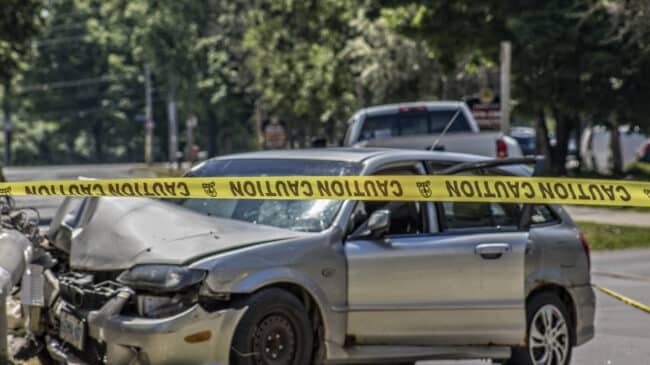In April, the National Highway Traffic Safety Administration (NHTSA) released preliminary statistical projections estimating that 2021 would set a gruesome record with 42,915 traffic fatalities, up 10.5% from 2020’s startling 38,824 road deaths and a 7.6% increase over 2019’s 36,096 fatalities. This troubling upward trend in dangerous driving during the COVID-19 pandemic must be analyzed to better understand the causes and evaluate the effectiveness of potential safety countermeasures. If there is any good news, it is that while dangerous driving remained elevated through 2021, a closer look at the data suggests the worst may be behind us.
Despite the 10.5% increase in estimated traffic fatalities from 2020 to 2021, the annual fatality rate remained flat. Further, the annual fatality rate decomposed into quarterly and monthly rates shows that overall fatal crash risk was slowly declining through 2021, which suggests understanding the causes of the fatality rate spike that began in the second quarter of 2020 will be key to an effective safety response.
NHTSA’s projection that nearly 43,000 were killed last year on U.S. roadways is a grim reminder that road transportation can be hazardous. It is also important to put these fatalities in a risk-based context, specifically by controlling for the population’s exposure to hazardous driving conditions. This allows us to make relative risk comparisons over time, by geography, and for a number of other characteristics that change in population or travel volume would otherwise obscure. In NHTSA’s case, we often see this expressed in terms of a fatality rate per 100 million vehicle miles of travel.
In 2020, the U.S.’s annual traffic fatality rate was 1.34. For 2021, NHTSA estimates an annual rate of 1.33, even though the fatality count increased by more than 10% between 2020 and 2021. This is because Americans drove more, increasing exposure to hazardous driving conditions even though average driving conditions in 2021 did not become more hazardous than those of 2020.
If one examines the quarterly fatality rates of the last decade (see table below), seasonal oscillation in fatality rates becomes clear. From these data, it is apparent that a massive spike occurred in the second quarter of 2020 as the coronavirus pandemic began, with the year-over-year fatality rate increasing by more than 30%. This occurred while the year-over-year fatality count for the second quarter actually fell 0.6% because of fewer vehicle miles of travel during the pandemic’s initial spring 2020 lockdowns.
Table 1: Quarterly Traffic Fatality Rates (deaths/100M VMT), 2011-2021*
| 1st Quarter | 2nd Quarter | 3rd Quarter | 4th Quarter | Full Year | |
| 2011 | 0.98 | 1.09 | 1.18 | 1.17 | 1.10 |
| 2012 | 1.08 | 1.12 | 1.21 | 1.16 | 1.14 |
| 2013 | 1.04 | 1.07 | 1.17 | 1.16 | 1.10 |
| 2014 | 0.99 | 1.03 | 1.11 | 1.17 | 1.08 |
| 2015 | 1.03 | 1.08 | 1.20 | 1.21 | 1.15 |
| 2016 | 1.11 | 1.16 | 1.23 | 1.27 | 1.19 |
| 2017 | 1.12 | 1.13 | 1.21 | 1.20 | 1.17 |
| 2018 | 1.10 | 1.11 | 1.18 | 1.15 | 1.14 |
| 2019 | 1.05 | 1.09 | 1.18 | 1.14 | 1.11 |
| 2020 | 1.08 | 1.43 | 1.44 | 1.40 | 1.34 |
| 2021* | 1.25 | 1.34 | 1.37 | 1.35 | 1.33 |
Looking even more closely at NHTSA’s monthly fatality figures, the pandemic fatality rate spike began in April 2020 and peaked in June 2020. The June 2021 fatality rate was down 11% relative to the June 2020 peak. Comparing the months of April through December for 2020 and 2021, the year-over-year monthly fatality rates declined by 3% on average. While the overall fatality rate remains elevated and data from 2022 will be important to establish a firm trend, there is reason to be cautiously optimistic that the worst is behind us and driving conditions are becoming less hazardous.
In May, NHTSA followed up its initial release of 2021 projections with a summary breakdown of crash fatalities by subcategory. While rural roads had much greater fatality rates than urban roads, urban roads—especially non-Interstate arterials and local roads—became much more dangerous over the last two years. Between 2020 and 2021, rural road fatalities increased 4% to 17,504 while urban road fatalities increased 16% to 25,411, with the urban fatalities share increasing from 56% to 59% of total fatalities. Fatality rates appear to be declining or at least plateauing across most roadway functional classifications, but remain elevated well above 2019 levels.
Table 2: Traffic Fatality Rates by Roadway Functional Classification, 2019-2021*
| 2019 Fatality Rate | 2020 Fatality Rate | 2021 Fatality Rate* | |
| Rural Interstate | 0.76 | 0.80 | 0.79 |
| Urban Interstate | 0.47 | 0.64 | 0.63 |
| Rural Arterial | 1.99 | 2.14 | 2.02 |
| Urban Arterial | 1.10 | 1.39 | 1.44 |
| Rural Local/Collector | 1.98 | 2.28 | 2.11 |
| Urban Local/Collector | 0.78 | 0.98 | 1.06 |
The last two years have been terrible for road safety in the U.S. An effective response will likely require a variety of countermeasures tailored to address specific local hazards, rather than a one-size-fits-all approach. The last edition of NHTSA’s biennial highway safety bible Countermeasures that Work was published in 2020. The 11th edition is due out later this year and will hopefully address the dangerous driving surge that occurred during the COVID-19 pandemic so state and local roadway owner-operators can mount effective responses.

